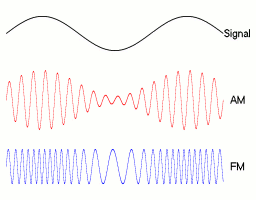AM broadcasting
AM broadcasting is a method of radio broadcasting using Amplitude Modulation (AM). It was the first method developed for making audio radio transmissions, and it is still used worldwide, primarily for medium wave (also known as AM band) transmissions, but also on the longwave and shortwave radio bands.
History[edit | edit source]
The history of AM broadcasting can be traced back to the early 20th century. The invention of amplitude modulation is attributed to Reginald Fessenden and Lee de Forest in the early 1900s. The first commercial AM radio station, KDKA in Pittsburgh, began broadcasting in 1920. This marked the beginning of the radio era, with AM radio becoming a vital means of communication, especially for long-distance audio transmission.
Technical Overview[edit | edit source]
AM broadcasting works by varying the strength (amplitude) of the transmitted signal in relation to the information being sent. For example, when broadcasting music or speech, the variations in amplitude correspond to the sound waves of the audio signal. This modulation technique contrasts with Frequency Modulation (FM), where the frequency of the carrier wave is varied.
Carrier Wave[edit | edit source]
In AM broadcasting, the carrier wave's amplitude is varied in proportion to that of the message signal, such as an audio signal. This carrier wave is generated at the radio station and is mixed with the audio signal to produce the AM signal, which is then transmitted through the airwaves.
Bandwidth and Frequency[edit | edit source]
The typical AM broadcast band ranges from 530 to 1700 kHz in the Americas, and from 531 to 1602 kHz in other parts of the world. Each station is assigned a specific frequency within this band. The bandwidth of an AM broadcast signal is determined by the highest frequency in the modulating audio signal. According to Carson's Rule, the total bandwidth required for AM broadcasting is twice the bandwidth of the modulating signal.
Advantages and Disadvantages[edit | edit source]
AM broadcasting has several advantages, including its simplicity and its ability to cover long distances, especially at night when AM signals can bounce off the ionosphere and travel thousands of kilometers. However, AM signals are more susceptible to noise and interference than FM signals. Noise from electrical equipment, atmospheric conditions, and other sources can degrade the quality of AM broadcasts.
Current Status and Future[edit | edit source]
Despite the rise of FM broadcasting, digital radio, and streaming services, AM broadcasting remains relevant, especially for news, talk radio, and sports broadcasting. In some regions, AM stations are an important source of information during emergencies. However, the future of AM broadcasting is uncertain, with some countries planning to phase out AM transmissions in favor of digital broadcasting technologies.
See Also[edit | edit source]
This article is a broadcasting-related stub. You can help WikiMD by expanding it!
Search WikiMD
Ad.Tired of being Overweight? Try W8MD's physician weight loss program.
Semaglutide (Ozempic / Wegovy and Tirzepatide (Mounjaro / Zepbound) available.
Advertise on WikiMD
|
WikiMD's Wellness Encyclopedia |
| Let Food Be Thy Medicine Medicine Thy Food - Hippocrates |
Translate this page: - East Asian
中文,
日本,
한국어,
South Asian
हिन्दी,
தமிழ்,
తెలుగు,
Urdu,
ಕನ್ನಡ,
Southeast Asian
Indonesian,
Vietnamese,
Thai,
မြန်မာဘာသာ,
বাংলা
European
español,
Deutsch,
français,
Greek,
português do Brasil,
polski,
română,
русский,
Nederlands,
norsk,
svenska,
suomi,
Italian
Middle Eastern & African
عربى,
Turkish,
Persian,
Hebrew,
Afrikaans,
isiZulu,
Kiswahili,
Other
Bulgarian,
Hungarian,
Czech,
Swedish,
മലയാളം,
मराठी,
ਪੰਜਾਬੀ,
ગુજરાતી,
Portuguese,
Ukrainian
Medical Disclaimer: WikiMD is not a substitute for professional medical advice. The information on WikiMD is provided as an information resource only, may be incorrect, outdated or misleading, and is not to be used or relied on for any diagnostic or treatment purposes. Please consult your health care provider before making any healthcare decisions or for guidance about a specific medical condition. WikiMD expressly disclaims responsibility, and shall have no liability, for any damages, loss, injury, or liability whatsoever suffered as a result of your reliance on the information contained in this site. By visiting this site you agree to the foregoing terms and conditions, which may from time to time be changed or supplemented by WikiMD. If you do not agree to the foregoing terms and conditions, you should not enter or use this site. See full disclaimer.
Credits:Most images are courtesy of Wikimedia commons, and templates, categories Wikipedia, licensed under CC BY SA or similar.
Contributors: Prab R. Tumpati, MD



